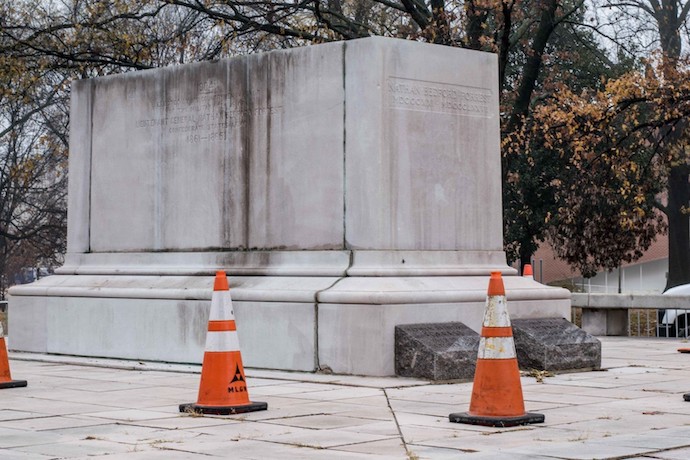High above the nine living justices of the Supreme Court, carved atop the marble columns of the highest courtroom in the land, sits the prophet Muhammad.
He’s not alone, obviously. Flanking him are Justinian and Charlemagne, and beside them all are other great lawgivers of history, standing side by side in a seven-foot-tall marble frieze installed in 1935.
Muhammad isn’t in this picture because American Muslims wanted him there. In fact, they’ve pointed out that such depictions are offensive to many Islamic communities, yet petitions to modify the frieze have been rejected by the court. Visitors to the building are now told that this representation—in which Muhammad clutches a scimitar and a Qur’ān whose “Arabic” is mostly gibberish squiggles—was simply a “well-intentioned attempt” to honor Islam’s most important figure.
Facing Muhammad, on the opposite wall of the court, stands Moses, holding his tablets. It’s perhaps convenient that while “do not kill” and “do not commit adultery” appear in the frieze, the prohibition on making graven images is nowhere to be seen.
The truth is that neither Moses nor Muhammad stood a chance against the basic American strategy of memorializing the dead with monuments. Under that strategy, the best dead are everywhere—and large, too. The worst are either removed or never depicted at all. Right now, as statues of Confederates and colonizers are being pulled down around the country, this same strategy underpins arguments by statue defenders that the toppling must stop. “George Washington was a slave owner,” President Trump pointed out during his now-infamous Charlottesville press conference in 2017. “Are we gonna take down statues of George Washington?”
We’re supposed to say no, I think, for no matter where we place the invisible line between “villain” and “important-but-problematic-historical-figure,” there’s widespread agreement that an America with no monuments—without a Rushmore, or a Lincoln Memorial, or an MLK, or 101 Washingtons in marble and bronze—would be an America that had lost itself in the heat of an acrimonious divorce from its own past. Statues are the anchor of history. To keep them is to remember; to topple them, willfully or otherwise, is to forget.
But this frame, so often assumed by preservationists, abolitionists, and the people in between, is clearly wrong. Statues don’t hold us to history. Though it’s symbolically powerful and worthwhile, eliminating every Confederate statue won’t eliminate racism, just as eliminating every presidential statue wouldn’t eliminate the idea of America. The tie between memory and statuary is more American than Americans realize. Given that many Americans don’t know that the Civil War happened after the War of Independence, and that the president this week misidentified a sculpture while defending its importance to memory, it’s questionable whether our memorializing strategies have been all that successful in the first place.
Given this dubious track record, we would do well to consider what American memory would look like without the benefit of monuments—or even, perhaps, if we actively opposed the creation of new monuments, especially when they involve our most cherished heroes. While these policies may sound heretical to American ears, many religious traditions—including Judaism, Islam, and some forms of Christianity—take them quite seriously. Nobody considers these faiths to be forgetful; in fact, quite the opposite. In the present moment, it’s worth understanding how anyone could be so opposed to this passion of ours.
Let’s return to Muhammad and Moses. The aversion to icons in Judaism and Islam is frequently overstated, but foundational texts in both traditions do communicate a real anxiety that images, even well-intentioned ones, are mistakenly given more significance than they should rightfully claim. “They have mouths but cannot speak; they have ears but cannot hear,” says the book of Psalms about idols. On the Day of Judgment, according to one hadith, God will challenge those who have made images, saying, “Bring to life what you have created.”
For both faiths, the key concern is that images attract worship in their own right. Because of this, anxiety around the representation of everyday items, like animals or common people, has historically been low, whereas the depiction of prophets, or of God, has attracted the greatest criticism. People, these faiths have recognized, have a habit of mistaking depictions of greatness for greatness itself.
None of this, crucially, has anything to do with memory. Judaism, Islam, and other faiths have endless options for memorializing their most important figures, including religious practice and the production and study of text. Unlike icons, the memories created by these techniques are dynamic and subjective, and their manifestation is often too complicated for simple representations. Against these complex memories, the compelling bluntness of images and monuments can in fact stand in opposition to memory, crowding out understandings that might otherwise have been multi-dimensional.
In our present American moment, this monumental hazard—that statues can flatten history rather than preserve it—needs to be taken very seriously. Not a single event or figure of the American story is well-served by simplification; in fact, as the New York Times’ 1619 Project has made clear, the project of racial justice is inherently bound up in a full reckoning with our past.
Conducting this reckoning involves more than just deciding which statues deserve preservation and which should be dropped into the sea. It means questioning whether the statue itself deserves such a lauded place in our culture, in much the same way that “defund the police” asks us to reconsider the role of law enforcement in our society. Monuments, too, can be defunded; we can place a moratorium on new statues and funnel those resources into something with a better chance of educating our citizens, like education.
People can be preserved in stone and in bronze, but they can also be preserved in words, in ideas, and in traditions. When we choose to memorialize a person in a way that freezes them at a specific moment of their life—literally in a specific posture—we communicate that we want our memory of that person to be similarly frozen; to be, in other words, a monolith. America’s great figures are not monoliths—and, as we’re constantly learning, there’s a real harm in understanding them to be so. Perhaps statues themselves are not a good fit for a country whose triumphs and shames are so inextricably connected. Beyond the question of which statues should be preserved and which should be toppled, we should renew our commitment to understanding our history not as one of stone and steel, but of flesh and blood.





